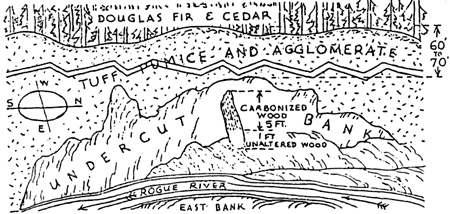Quatrains of Crater Lake: Llao
By Ernest G. Moll, Ranger-Naturalist
Great bird of fire, cold now, and gray, and lone,
Ten thousand years have seen you never wake,
Ten thousand more shall know your breast of stone,
Brooding far up above the silent lake.
A Buried Log in Rogue River Tuffs and Agglomerates
By Warren D. Smith, Ranger-Naturalist
On July 27, 1934, Nelson Reed and the writer went down the Rogue River about one mile below where the Diamond Lake Road crosses Rogue River to investigate a newly discovered buried log site. At the place indicated, Mr. Reed had discovered a buried log in the tuff and agglomerate on the west bank of the Rogue River.
The log is of cedar, nearly three feet in diameter, with some six to eight feet exposed, standing nearly vertical, and embedded with some sixty to seventy feet of fragmental material above it. The upper part of this log is charred, while the lower one to two feet is apparently little changed; it appears that the tree was quickly entombed and hermetically sealed by hot material. This tree was evidently standing and probably alive and flourishing when the explosive material was thrown out, and the blast seems to have pushed the tree down the slope at an angle of 74° away from the center of disturbance. This find ties up very well with the discovery made by Mr. D. S. Libbey farther east on the Diamond Lake Road, but in this find we have a standing, instead of prone log. Furthermore, this tree bole is only partly carbonized.
Specimens of the unaltered wood from this tree were submitted to Doctor E. I. Applegate, Ranger-Naturalist, and Mr. Shirley Allen of the United States Forest Service and both pronounced it as “most likely” cedar. It is quite probable that much the same type of forest as is now growing there was growing in this region prior to the time of entombment of this specimen. This locality is now covered with a magnificent Douglas Fir forest in which many cedars are found.
Below is a sketch of the deposit and the long as partly exposed by the river under-cutting the bank.


